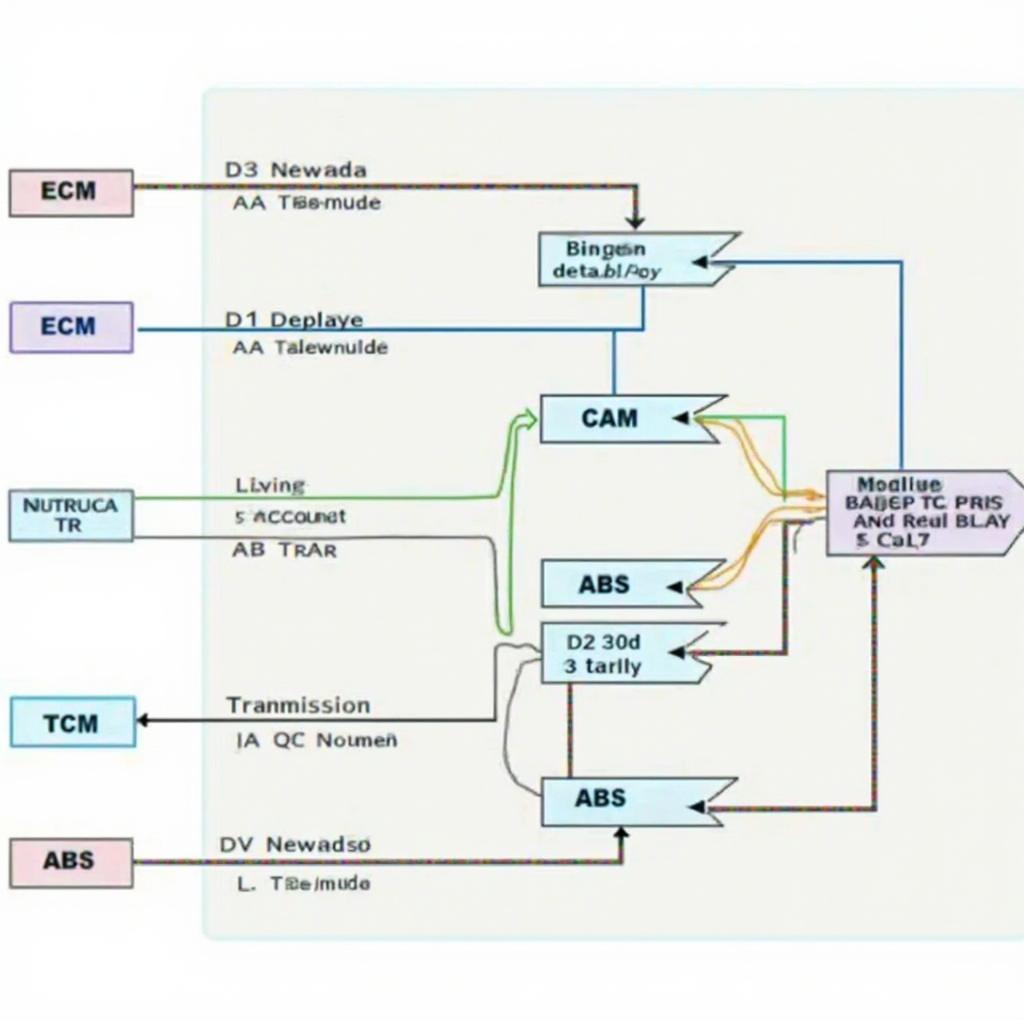The OBD2 CAN bus protocol is the backbone of modern vehicle diagnostics. It’s the language your OBD2 scanner speaks to access the wealth of information hidden within your car’s computer systems. This article dives deep into the CAN bus protocol, exploring its functionality, benefits, and importance for both everyday car owners and automotive professionals.
The Controller Area Network (CAN) bus protocol is a robust and efficient communication system used in most modern vehicles. It allows various electronic control units (ECUs) within the car – such as the engine control module, transmission control module, and anti-lock brake system – to communicate with each other without a central host computer. This decentralized approach offers significant advantages in terms of speed, reliability, and wiring simplicity. Imagine a network of interconnected computers sharing information in real-time, allowing your car to optimize performance, diagnose issues, and enhance safety features. That’s the power of the OBD2 CAN bus protocol. Want to learn more about OBD2 and CAN bus issues? Check out this resource on obd2 iso canbus protocol failed.
What is the CAN Bus in OBD2?
The CAN bus in OBD2 acts as the central nervous system of your vehicle, enabling the seamless flow of diagnostic data between the various ECUs and your OBD2 scanner. This standardized protocol ensures compatibility across different makes and models of vehicles, allowing you to access a wide range of information about your car’s health and performance.
How Does the OBD2 CAN Bus Protocol Work?
The OBD2 CAN bus protocol uses a differential signaling system, transmitting data over two wires. This method helps to minimize electromagnetic interference, ensuring reliable communication even in harsh environments. Data is transmitted in packets, each containing an identifier that specifies the intended recipient and the type of information being transmitted. This allows multiple ECUs to share the same bus without conflicts.
 OBD2 CAN Bus Protocol Data Transmission
OBD2 CAN Bus Protocol Data Transmission
Benefits of the OBD2 CAN Bus Protocol
The OBD2 CAN bus protocol offers several key advantages:
- Reduced Wiring Complexity: The CAN bus significantly reduces the amount of wiring required in a vehicle, leading to lower weight and improved reliability.
- Improved Diagnostics: The standardized protocol makes it easier to diagnose problems, as all vehicles use the same communication method.
- Enhanced Real-time Monitoring: The CAN bus allows for real-time monitoring of various vehicle parameters, enabling sophisticated control systems and improved performance.
- Increased Safety: By enabling communication between safety systems like ABS and airbags, the CAN bus contributes to a safer driving experience. If you’re concerned about high voltage issues within your vehicle’s CAN bus system, you might find our article on obd2 can bus high voltage helpful.
Common Issues with the OBD2 CAN Bus Protocol
While the CAN bus is a robust system, issues can sometimes arise. These can include wiring problems, faulty ECUs, or software glitches. Diagnosing these problems requires specialized equipment and knowledge.
Troubleshooting OBD2 CAN Bus Problems
Troubleshooting CAN bus issues often involves checking for communication errors, examining wiring harnesses, and testing individual ECUs. A professional mechanic with the right tools and expertise is usually best equipped to handle these complex diagnostics.
Future of the OBD2 CAN Bus Protocol
The OBD2 CAN bus protocol is constantly evolving to meet the demands of increasingly complex vehicle systems. Future developments are likely to include higher data rates, improved security features, and greater integration with other vehicle networks.
What is the Difference Between 11-bit and 29-bit CAN?
The primary difference between 11-bit and 29-bit CAN lies in the number of identifiers available for addressing messages. 11-bit CAN provides a smaller address space, suitable for simpler networks. 29-bit CAN, on the other hand, offers a significantly larger address space, accommodating the needs of more complex networks found in modern vehicles. This expanded address space is crucial for managing the increasing number of ECUs and the growing volume of data exchanged within these systems. For further information about 11-bit OBD2 systems, you can visit our dedicated page: is obd2 11 bit.
“The automotive industry is moving towards increasingly sophisticated communication systems,” says automotive electronics expert, Dr. Emily Carter. “The CAN bus protocol is at the heart of this evolution, enabling the development of advanced driver-assistance systems and autonomous driving technologies.”
Conclusion
The OBD2 CAN bus protocol is a vital component of modern vehicles, facilitating communication between various electronic systems. Understanding this protocol is crucial for anyone working with automotive diagnostics, from DIY enthusiasts to professional mechanics. For those interested in using J1939 protocols with their OBD2 setup, we have a guide on j1939 obd2 adapter that might be useful. By grasping the fundamentals of the OBD2 CAN bus, you gain a deeper insight into how your vehicle functions and how to effectively diagnose and resolve potential issues.
FAQs
- What does OBD2 stand for? On-Board Diagnostics, Second Generation.
- What is the purpose of the CAN bus? To allow various electronic control units (ECUs) within the car to communicate.
- Can I access the CAN bus data myself? Yes, with an OBD2 scanner and compatible software.
- What are common CAN bus problems? Wiring issues, faulty ECUs, or software glitches.
- How can I troubleshoot CAN bus problems? Using specialized equipment like a multimeter or CAN bus analyzer, or consulting a professional mechanic.
- Is the CAN bus used in all cars? Most modern vehicles utilize the CAN bus protocol.
- What is the future of the OBD2 CAN bus? Higher data rates, improved security, and greater integration with other vehicle networks.
If you’re looking for reliable diagnostic software, you can explore options for free downloads: obd2 bluetooth diagnostic software free download.
Need help with your car diagnostics? Contact us via WhatsApp: +1(641)206-8880, Email: [email protected] or visit our office at 789 Elm Street, San Francisco, CA 94102, USA. We offer 24/7 customer support.

